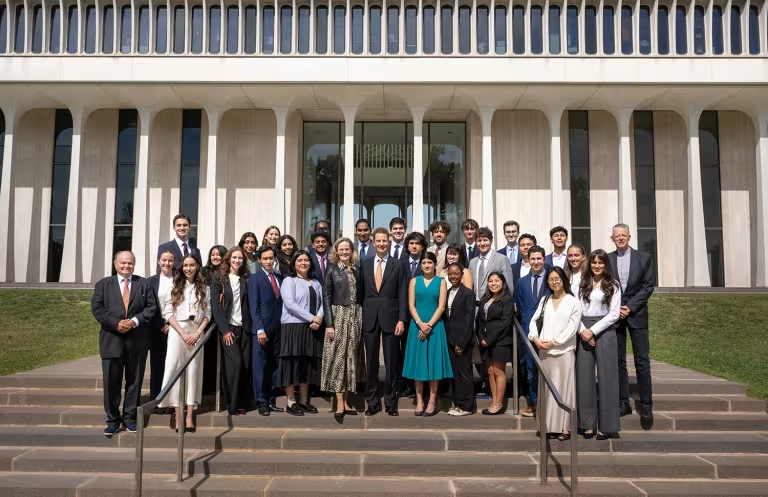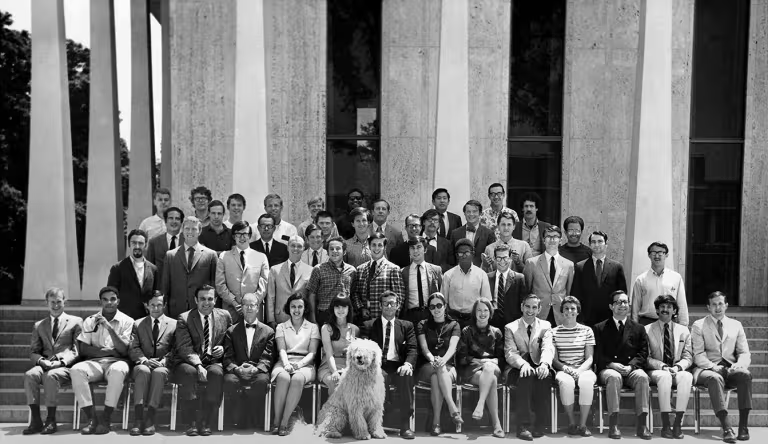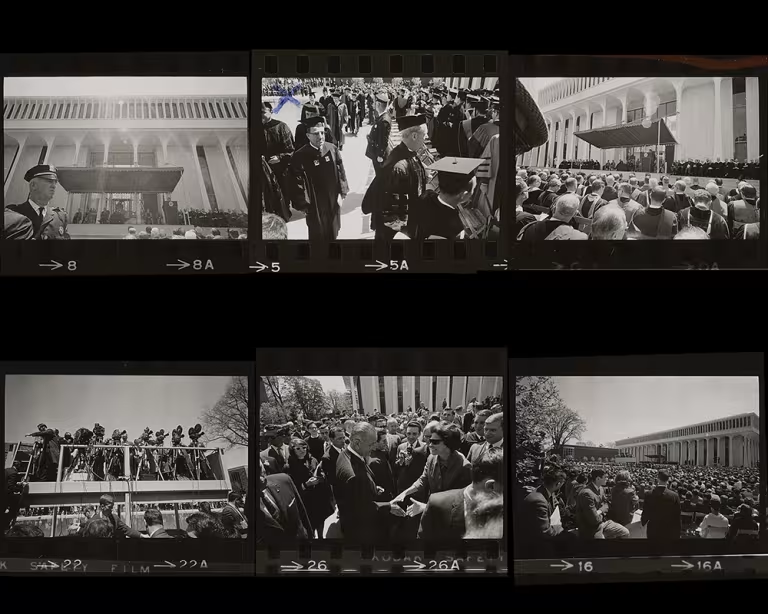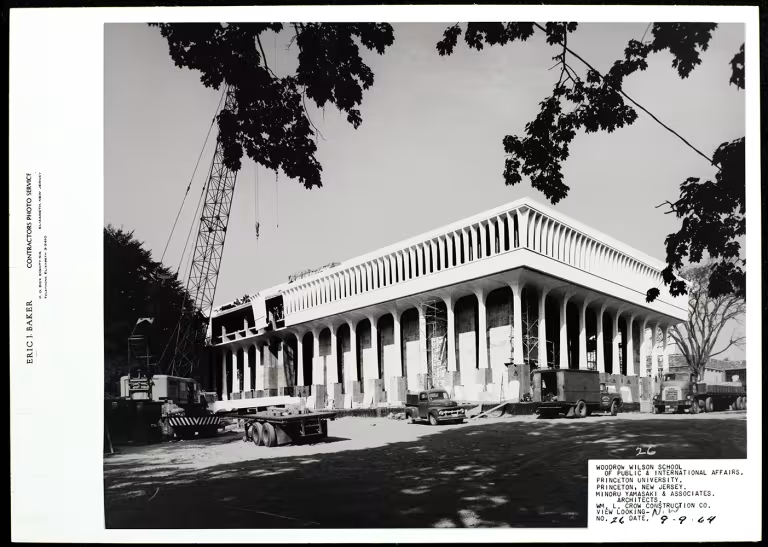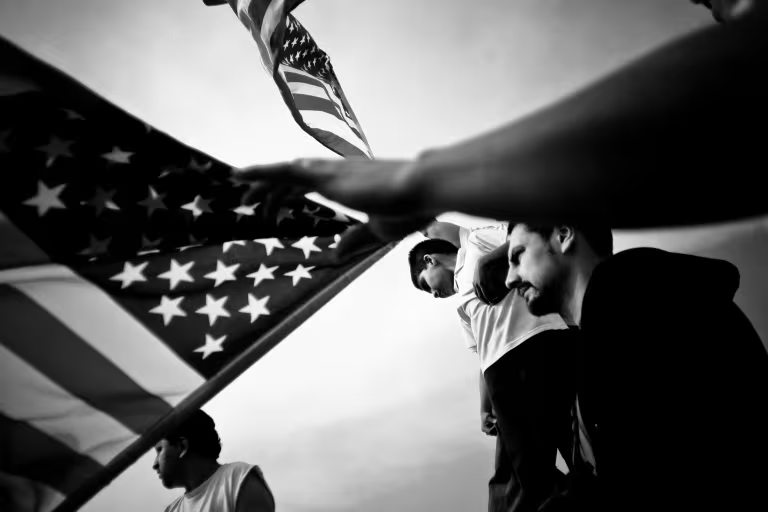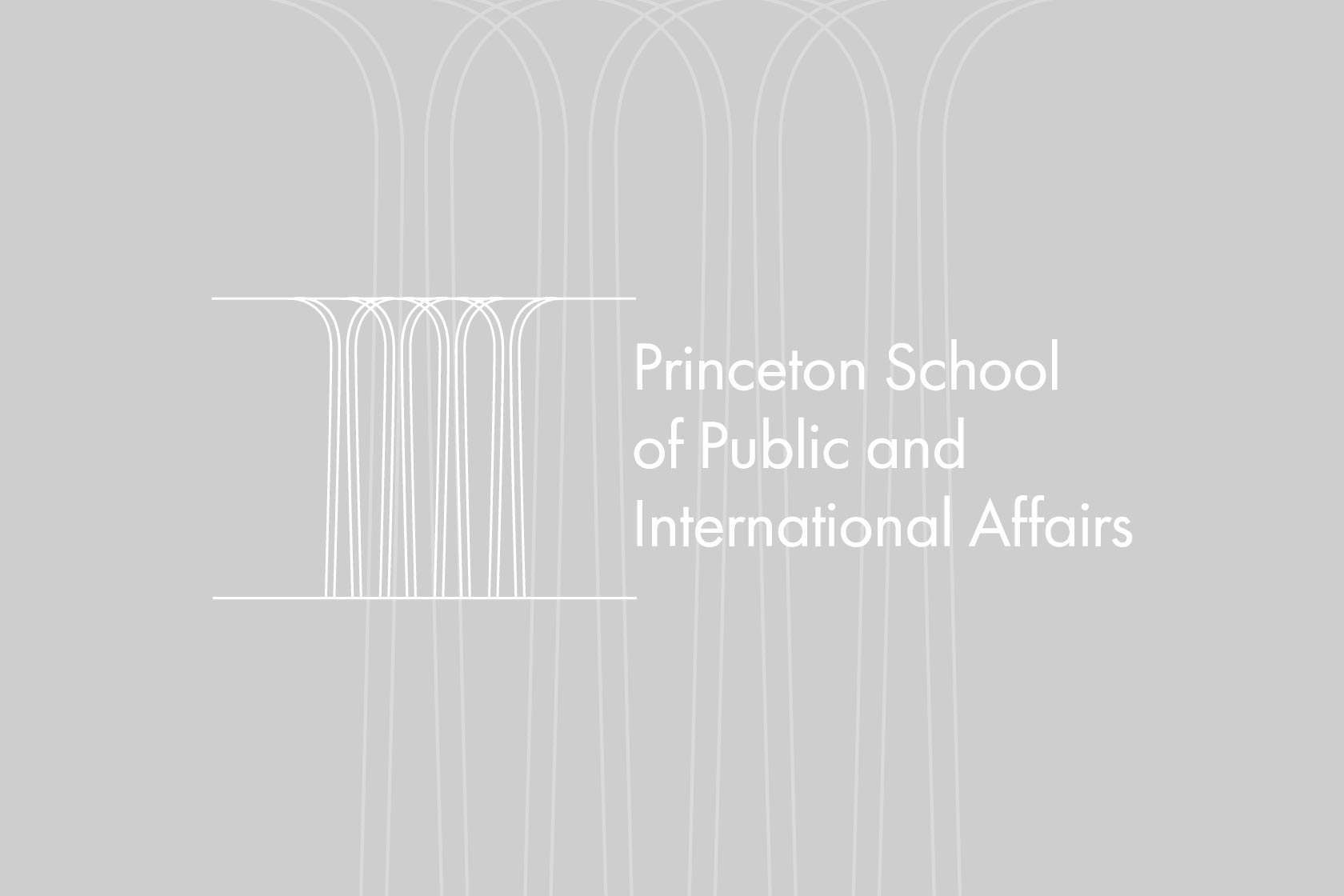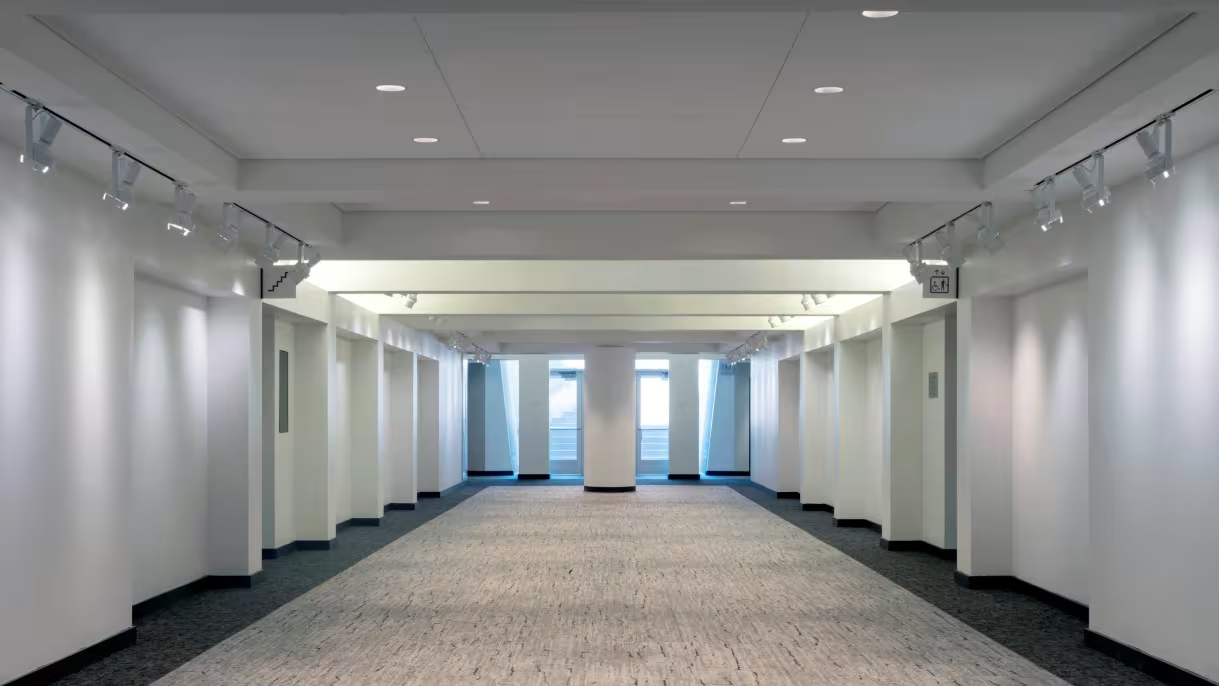
Bernstein Gallery
About the Gallery
The School’s Bernstein Gallery is dedicated to art exhibitions that stimulate thinking about contemporary policy issues. Each year, the gallery presents curated shows to Princeton University students, faculty, staff, and the community at large. The exhibitions are complemented by receptions and panel discussions with artists, experts from Princeton University, the School, and outside organizations. Integrated with the School’s multidisciplinary approach, the goals of the gallery over the last 15 years have been to enhance the impact of the course curriculum and to deepen people’s commitment to the ideals of public service.
Hours & Information
The gallery is located in the Bernstein Lobby, lower level of Robertson Hall, which memorializes Marver Bernstein, the School’s first dean, and his wife, Sheva.
The gallery is free and open to the public. Hours during the academic year are Monday through Friday, 9 a.m. to 5 p.m.
The Liechtenstein Institute on Self-Determination at 25
For a quarter century, the Liechtenstein Institute on Self-Determination (LISD) has sponsored academic research, teaching, public outreach, policy interventions, and student activities centered on self- determination in international affairs.
The principle of self-determination lies at the heart of modern world politics. It denotes a universal desire for autonomy, recognition, and belonging. Nations and communities assert their right to shape their own political destiny. Social and cultural groups demand equality, inclusion, and a chance to realize diverse collective identities. Individuals seek dignity, human rights, political voice, and freedom from arbitrary power and coercion. These forms of self-determination are both moral imperatives and fundamental forces shaping global affairs.
In 2000, an endowment grant from the princely family of Liechtenstein founded LISD within Princeton’s School of Public and International Affairs. This generous act reflected a long-standing concern with self- determination on the part of HSH Hans-Adam II, the reigning prince of Liechtenstein, as well as his prior academic engagement with LISD’s Founding Director Dr. Wolfgang Danspeckgruber.
Over the last two and a half decades — since 2020 with Prof. Andrew Moravcsik as director — LISD has engaged in research, policy analysis, diplomatic interventions, teaching, and outreach on various topics in world politics. It has broadened the thematic diversity and geographical scope of its activities. It has increased the number of Princeton students, faculty, and fellows involved in its activities. Its partnerships inside and outside the university have expanded.
Pillars
Reflecting on notable events from the previous three quarters of a century at the Princeton School of Public and International Affairs, Pillars presents over 70 images gathered from both public and private collections. From innovative architecture setting the tone for the conversations within, to the array of deans and faculty whose visions shape the program, to the students and alumni who give purpose to it all, this collection of images offers an opportunity to look back at the architectural, philosophical, and academic pillars that support this institution.
Featuring events that have taken place over the previous 75 years, the exhibition highlights the role of the Master in Public Affairs at Princeton SPIA as it wraps up its diamond anniversary celebration. On the occasion of this exhibition, several artifacts from SPIA’s archives, housed at the Seeley G. Mudd Manuscript Library, have been digitized and are here on public display for the first time.
An architectural icon on Princeton’s campus and home to SPIA, Robertson Hall brings the democratic ideals of the Parthenon into a modern conversation. Its distinctive pillars draw the eye upward, calling attention to the higher purpose of education. They inspire its occupants to think boldly about the big questions, ready to imagine what comes next. Over generations, SPIA’s students have answered the call, building a community grounded in inquiry, service, and impact—a community that continues to evolve with the world it serves.
Past Exhibitions
Inherit America
This exhibit brought together the longstanding collaboration between anthropologist Laurence Ralph, co-director of the Center on Transnational Policing, and photographer Carlos Javier Ortiz whose visual storytelling critically explores the themes of criminal justice, urban violence, and systemic inequality.
Biographies
Carlos Javier Ortiz is a multidisciplinary artist whose work spans directing, cinematography, photography, and visual storytelling. Grounded in a humanist perspective, his practice explores urban life, structural inequality, and social justice through intimate narratives and compelling imagery. Influenced by social realism, Ortiz uses his work to foster empathy and provoke critical engagement with contemporary socio-political issues.
His photography and films have been exhibited both nationally and internationally, including at the Schomburg Center for Research in Black Culture, the Worcester Art Museum, the Library of Congress, and the International Museum of Photography and Film. His visuals notably accompanied Ta-Nehisi Coates' groundbreaking essay “The Case for Reparations” in The Atlantic.
Ortiz is a Guggenheim Fellow (2016) and a National Geographic Explorer (2021). Based in Chicago, he teaches documentary filmmaking at Columbia College and serves on the board of the Museum of Contemporary Photography at Columbia College Chicago (MoCP), demonstrating his deep commitment to craft, education, and community.
Laurence Ralph is a professor, writer, and filmmaker. His work explores how police abuse, mass incarceration, and the drug trade make injury and premature death seem natural for people of color. His first book, Renegade Dreams (University of Chicago Press, 2014), received the C. Wright Mills Award and the J.I. Staley Prize. His second book, The Torture Letters (University of Chicago Press, 2020), explores a decades-long scandal in which hundreds of Black men were tortured in police custody. The Torture Letters is also the name of his award-winning, animated short film, which is featured in The New York Times’ Op-Doc series. Laurence’s latest book, Sito: An American Teenager and the City that Failed Him, was released in 2024 by Grand Central Publishing. Laurence’s work has been featured in The Paris Review, The New York Times, The New York Review of Books, The Nation, The Chicago Review of Books, Boston Review and Literary Hub, to name a few.
Laurence has held tenured appointments in the Departments of Anthropology and African & African American Studies at Harvard University. Ralph has been awarded many fellowships for his work, some of which include the Guggenheim and Carnegie Fellowships, as well as grants from the National Science Foundation, the Wenner-Gren Foundation, and the National Research Council of the National Academies. He is a member of the Institute for Advanced Study, the Center for Advanced Study in the Behavioral Sciences, a fellow of the Radcliffe Institute for Advanced Study at Harvard University, and an elected member of the American Academy of Arts & Sciences.
“The Work of Elections: Greg Miller and Anna Rotty”
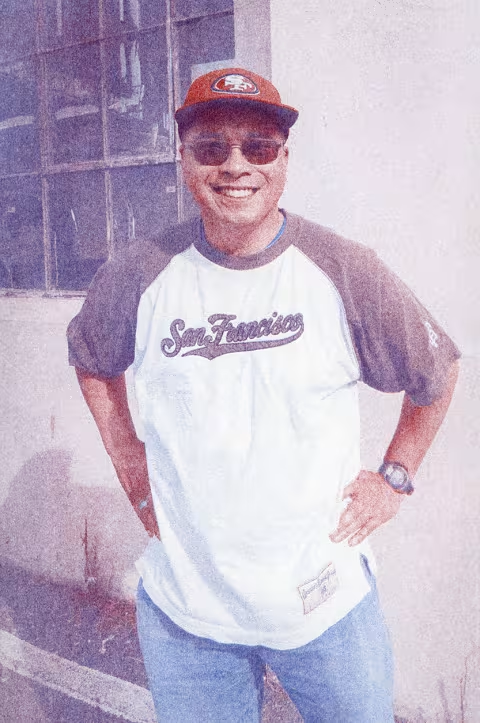

September 25–January 2025
Robertson Hall, Dodds Atrium
An exhibition of photographs by Greg Miller and Anna Rotty documenting and honoring the poll workers and community spaces that make elections work. Co-organized by P*LAW and SPIA, this show is a satellite presentation of the Bernstein Gallery and is located on the first floor of Robertson Hall, near Dodds Atrium.
About the Artists
Greg Miller is an American fine art photographer and Guggenheim Fellow. Dedicated to working with an 8×10 view camera, he has produced several bodies of personal work over the last 20 years including Nashville, Unto Dust, County Fair and, most recently, Morning Bus, photographs of local Connecticut children waiting for the morning school bus.
Miller’s work has been exhibited in several solo shows in Los Angeles, Barcelona and the Cheekwood Museum in Nashville, TN as well as group exhibits in New York City, including Yossi Milo, James Danziger and Sasha Wolf Galleries. His photographs are part of the permanent collections of the Museum of the City of New York, The George Eastman Museum and the Cleveland Museum of Art. His work has appeared regularly in advertising and magazines including TIME, LIFE, NPR, Esquire, Fast Company, and many other publications.
Anna Rotty is an artist and educator based in Albuquerque where she received her MFA, and currently teaches, at the University of New Mexico. She has served as an election official with the San Francisco Department of Elections from 2016–2021 and in Bernalillo County in New Mexico since 2022. Interested in the infrastructure of our built and natural world, Rotty uses photography as a tool to investigate systems and interact with her environment. She has recently exhibited at the University of New Mexico Art Museum, the Houston Center for Photography, Northlight Gallery at Arizona State University, Strata Gallery Santa Fe, and Chung 24 Gallery in San Francisco. Her work has been published by Southwest Contemporary, Humble Arts Foundation, and Lenscratch, where she earned 3rd place in the Student Portfolio Prize in 2023. This year Anna was a recipient of the Silver Eye Center for Photography Fellowship 24 in Pittsburgh. Her work is in collections such as The Museum of Fine Arts Houston, the Library of Congress, and San Francisco MOMA Special Collection. Her research includes working with Collective Constructs, a group of artists and art historians interrogating how museum collections are formed, and how we might contextualize what is unseen through sound, stories, and creative intervention. Later this year Rotty will open a solo exhibition at Texas Tech University exhibiting her series How We Hold the Sun, and she has accepted an artist in residence fellowship at MASS MoCA this December.
Close Encounters: Facing the Bomb in a New Nuclear Age
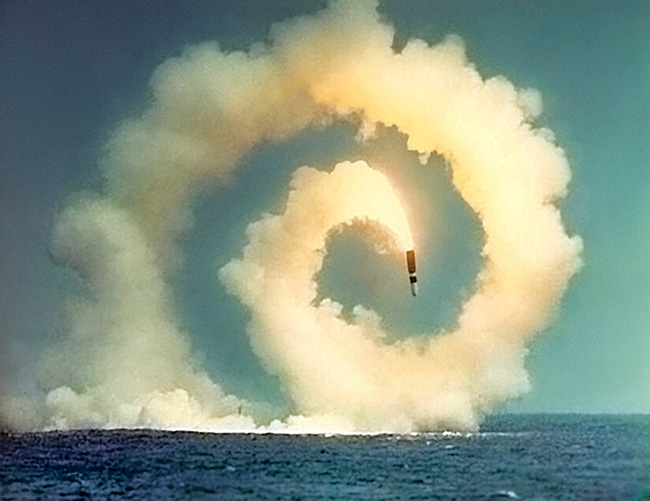
September 19–October 25, 2024
On the occasion of the 50th anniversary of the Program on Science & Global Security (SGS), part of the Princeton School of Public and International Affairs, this special exhibition at the Bernstein Gallery confronts the existence and threat of nuclear weapons. It marks the first stop of a national university tour of the bomb, a multimedia installation by Smriti Keshari and Eric Schlosser (’81).
Unfolding across forty-five screens, the bomb immerses viewers in the story of nuclear weapons, from the first nuclear test and subsequent use against Japan by the United States in 1945, to today’s arms race. It illuminates the thousands of nuclear weapons––held only by nine states––on land, underground, and at sea, many ready for launch. Though largely hidden from view, these weapons pose an ever-present existential threat to humanity.
Inspired by nuclear weapon command-and-control centers, the bomb’s design evokes the technological fallibility of such systems, the devastating consequences of errors and malfunctions, and the inherent impossibility of ever fully controlling these machines.
The exhibition also includes two short films produced by and for SGS:
Plan A is a simulation of escalating war between the United States and Russia. Using realistic nuclear force postures, war plans, targets, and fatality estimates based on data sets of nuclear weapons currently deployed and weapon yields, the work shows the evolution of the nuclear conflict from tactical to strategic to city-destruction phases.
We Must Speak Boldly – Physicists Coalition for Nuclear Threat Reduction is a reflection on current nuclear dangers and a call from scientists for more education and collective action to help address them. The Coalition was founded at SGS in 2019 and works for fulfillment of the long-standing international obligation to achieve nuclear disarmament.
Eight infographic panels by SGS are also on view. Installed along the gallery walls, they provide up-to-date information on the risks of nuclear weapons and nuclear materials, the local and global long-term effects of nuclear weapon use, the US nuclear weapons modernization plan and its expected costs, and current disarmament efforts, including the 2017 UN Treaty on the Prohibition of Nuclear Weapons.
Credits
the bomb (TRT: 60 mins) is created by Smriti Keshari & Eric Schlosser; Film by Kevin Ford, Smriti Keshari & Eric Schlosser; Installation Design: Ben Kreukniet; Music: The Acid; Art Director: Stanley Donwood; Animation: The Kingdom of Ludd; Installation Technical Lead: Adam Paikowsky, Greenhouse Media, Doug Hock; Installation Producer: Cherefawn Chang.
Plan A (TRT: 4 mins) is developed by Alex Wellerstein, Tamara Patton, Moritz Kütt, and Alex Glaser with assistance from Bruce Blair, Sharon Weiner, and Zia Mian. The sound is by Jeff Snyder.
We Must Speak Boldly – Physicists Coalition for Nuclear Threat Reduction (TRT: 6 mins) is commissioned by the Physicists Coalition. Director: Smriti Keshari; Producer: Hazel Gibson; Cinematographer: Nick Korompilas; Editor: Dani Benavides; Animation: The Kingdom of Ludd; Music: Matthew Herbert. Technical advice: Matt Caplan, Zia Mian, and Stewart Prager. Special thanks to participants in the Princeton School on Science and Global Security 2023.
Infographic panels: Alexander Glaser, Zia Mian, Tamara Patton, Sebastien Philippe, Sharon Weiner. Graphic design: Kraenk Visuell.
Biographies
Smriti Keshari is a multimedia artist and filmmaker whose work spans traditional, linear filmmaking and art installations. She brings an experimental approach to exploring underrepresented themes. Keshari is a former artist-in-residence at Pioneer Works, an art space in Brooklyn, NY, and at the National Theatre in London. She was a TED Prize finalist and one of Foreign Policy’s Global Creative Thinkers for 2016.
Eric Schlosser (’81) is a writer whose work has been published in dozens of countries, performed on stage, and adapted into films. His book, Command and Control, tells the story of America’s effort to prevent its nuclear weapons from being stolen, sabotaged, or detonated by accident. It was a New York Times best seller and a finalist for the 2014 Pulitzer Prize in History. He was among Foreign Policy’s Global Creative Thinkers for 2016.
Mira Dayal – Complex Tokens
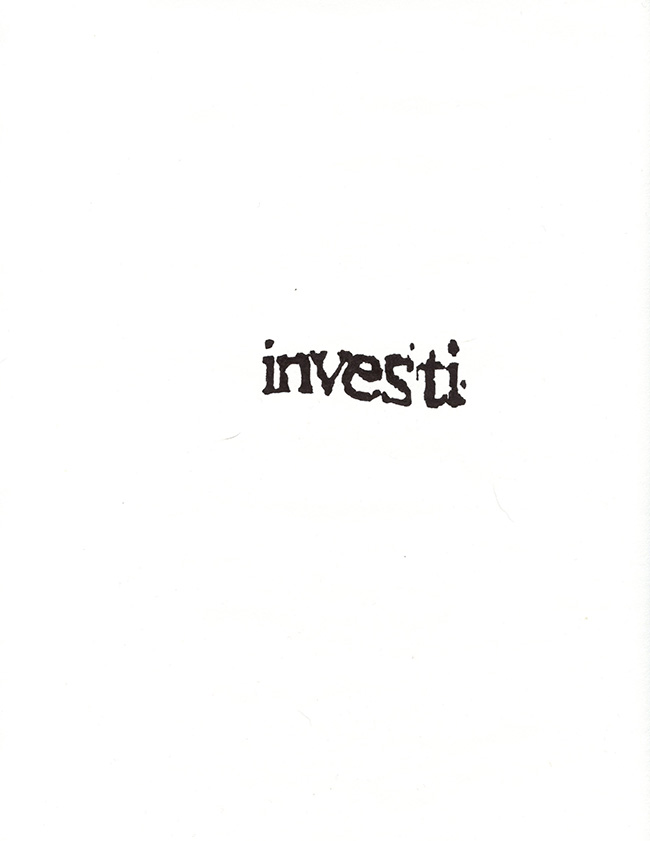
March 18–June 7, 2024
The Bernstein Gallery presents “Complex Tokens,” an exhibition of work by Mira Dayal. The show explores evolving approaches to language as a tool for encryption, and is anchored by a series of ink-on-paper drawings of reCAPTCHA texts, introduced to further levels of distortion by the artist’s hand. From those drawings, Dayal compiled the “token ID” numbers that OpenAI would use to understand the text, and created the corresponding numbers of clay “tokens,” arranged into grids. These small objects recall the pre-linguistic clay tokens thought to have been used by ancient Mesopotamian societies to count and record collective holdings of goods and livestock such as grain and sheep. Dayal has also created a series of cylinder seals with distorted text fragments laser-etched into their surfaces. Made from drawing materials, the graphite or chalk cylinders resemble stone and appear at times organic and at times mass-produced. In many ancient cultures, cylinder seals were used for bureaucratic purposes akin to authorizing documents. The stone would be rolled across wet clay, revealing the marks carved into its surface. Because of their fragility, Dayal’s seals cannot be used to make impressions, and thus cannot be entirely decoded.
Biography
Mira Dayal is an artist, writer, editor, and educator based in New York. Her studio work involves subtle, laborious applications of materials; critical reflections on changing technologies; and formal explorations of the limits and systems of language. Her work has been shown at Barnard College, Parent Company, Spencer Brownstone Gallery, Hesse Flatow, Gymnasium, Lubov, NURTUREart, NARS Foundation, and Abrons Art Center in New York, as well as lower_cavity, Holyoke, MA; Artspace New Haven; Apparatus Projects, Chicago; STNDRD, Granite City, IL; OCHI, Los Angeles; Kunstverein Dresden, Germany; and other spaces. She has participated in residencies and intensives at Ox-Bow, Art in General, and A.I.R. Gallery. Dayal is currently on faculty at Barnard College and the School of Visual Arts and has previously taught at Hunter College and the International Center of Photography.
Organized by Lina Kavaliunas, Curator, Bernstein Gallery
Princeton Affordable Housing Map
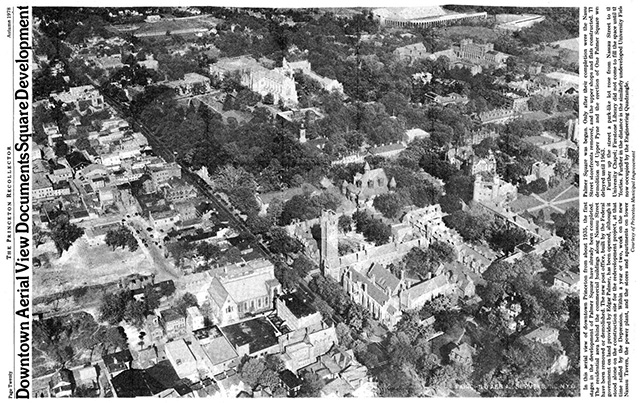
November 21, 2023–February 23, 2024
The Princeton Affordable Housing Project collects and records histories related to affordable housing in Princeton, NJ. Initiated in the summer of 2020, as calls for racial justice were sounded across America and thousands took to the streets under the Movement for Black Lives, the project seeks to understand how stark housing inequality in the municipality came about and provoke questions and suggestions for future development in housing.
Phase one of the project resulted in the creation of an interactive map, published online and freely accessible to all. A second research phase took place in January 2021. This exhibition presents a physical version of the Princeton Affordable Housing Map, offering viewers a tour of Princeton’s affordable housing landscape, past and present, and illustrating the challenges and necessity of affordable housing in Princeton today.
Please visit the virtual Affordable Housing Map here.
The project originated with the Princeton Civil Rights Commission (CRC) and was produced by both volunteers and grant-supported fellows with support from Princeton University’s PACE Center, the School of Public and International Affairs, and the School of Architecture.
MARIUPOL
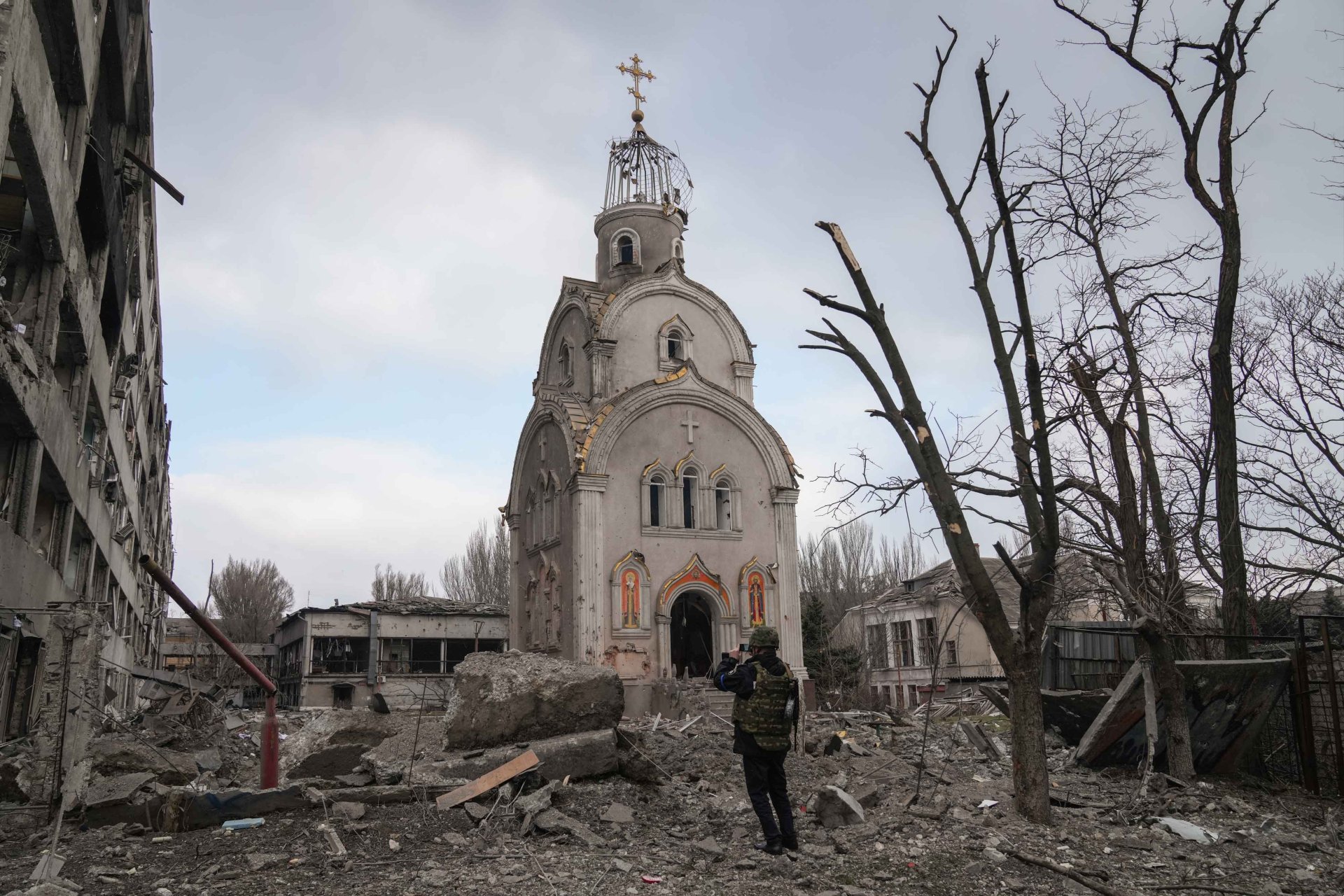
October 6 – November 10, 2023
On the 24th of February 2022, the Russian Federation commenced a full-scale invasion of Ukraine. An hour before the attack’s apocalyptic beginnings, three Ukrainian journalists from the Associated Press—Evgeniy Maloletka, Mstyslav Chernov, and Vasilisa Stepanenko—arrived in the eastern port city of Mariupol. They had driven through the night, sensing the impending war and painfully aware of the city’s strategic significance for the Kremlin. An industrial center on the coast of the Sea of Azov, Mariupol lies along major routes between Crimea to the west and the border with Russia to the east. In 2014, as fighting erupted in the Donbas, the city was captured briefly by Russian-backed separatists. Ukrainian forces quickly reclaimed Mariupol, but the sounds of war were always near. Eight years later, the violent conflict in the east escalated into catastrophe.
Some people evacuated, but many more remained in Mariupol. The city was soon surrounded by Russian forces. Suddenly leaving was impossible. The invaders destroyed the city’s infrastructure, cutting off access to information and disabling the electricity, water, and gas supplies. People drank melted snow and scavenged the city’s remains for food and firewood. The shelling was relentless. Neighbors hid together in basements and improvised bomb shelters. Survivors emerged during breaks in the violence to collect and bury the dead. The bodies of grandmothers and children and friends and sisters and fathers were all placed together in mass graves dug into the frozen ground.
Presented chronologically in this exhibition, the images by Maloletka and Chernov bear witness to the destruction wrought on Mariupol at the war’s outset. The AP photographers were the only international media remaining in the city under siege, the only journalists able to transmit video and still photographs during the first weeks of the blockade. When Russian troops entered the city, they knew what would happen if they were caught. They had to get themselves, and their footage, out. On March 15, alongside thousands of civilians, the team escaped Mariupol through a “green corridor” that had finally been opened. There was no telling when, or if, they would ever return.
As the war pushes on, these photographs fight against forgetting. They speak for the agony of Mariupol, carrying forward evidence of the violence inflicted upon the city’s people, confronting the world with the incomprehensible terror of what happened. The siege ended after more than eighty days. Mariupol has been occupied by Russia since May 2022.
Biography
Evgeniy Maloletka is a Ukrainian war photographer, journalist, and filmmaker who has been covering the war in Ukraine since 2014. He has also covered the Euromaidan Revolution, the protests in Belarus, the Nagorno-Karabakh war, and the COVID-19 pandemic in Ukraine. In 2023, he received numerous international awards for his photographs, including World Press Photo of the Year and two Pulitzer Prizes, one for public service, which he shares with his AP Mariupol team, and another for breaking news photography.
Mstyslav Chernov is a Ukrainian war correspondent, filmmaker, photographer, and novelist known for his coverage of the Ukrainian revolution, the Russian invasion in Ukraine, the war in Iraq, Syria, and Nagorno-Karabakh, and Afghanistan under Taliban rule after U.S. withdrawal, as well as for his art installations and exhibitions. Video he shot in Mariupol became the basis of his film 20 Days in Mariupol, which won the Audience Award in World Cinema Documentary at the Sundance Film Festival in 2023. He shares the 2023 Pulitzer Prize for Public Service with Evgeniy Maloletka and Vasilisa Stepanenko.
The exhibition is presented by the Bernstein Gallery and Yara Arts Group, New York

Robert Shetterly: Truth Tellers
March 20–May 31, 2023
What are the obligations of citizenship? How does dissent safeguard democracy? How can we demand the truth from politicians and the media? These are some of the questions that animate artist and activist Robert Shetterly’s ongoing series Americans Who Tell the Truth.
For over twenty years, Shetterly has painted portraits of citizens who address issues of social, racial, economic, and environmental justice. The series began in 2002, during the aftermath of the September 11th attacks and amidst the lead-up to the Iraq War, and grew out of Shetterly's desire to honor those who spoke truth to power. Since then, the series has grown to include over 250 paintings that depict a diverse range of individuals, including artists, writers, political leaders, whistleblowers, and educators.
The paintings on view in this exhibition portray people who became activists at a young age. The intergenerational group ranges from famed Princeton-born singer, actor, and civil rights activist Paul Robeson (1898–1976) to Charlottesville student organizer Zyahna Bryant (b. 2001). The exhibition includes portraits of labor organizers Emma Tenayuca (1916–1999) and Ai-Jen Poo (b. 1974); environmentalists Lois Gibbs (b. 1951), Kandi Mossett (b. 1980), and Kelsey Juliana (b. 1996); and peace activists Camilo Mejía (b. 1975) and Channapha Khamvongsa (b. 1973). Other individuals represented include healthcare and economic justice activist Ady Barkan (b. 1983); the founder of the “Me Too” Movement, Tarana Burke (b. 1973); civil rights lawyer and television commentator Van Jones (b. 1968); LGBTQ+ advocates Nicole and Jonas Maines (b. 1997); and the Bay Area civil rights advocate Lateefah Simon (b. 1977), who is also a 2024 congressional candidate.
Although their dedication to their respective causes began early in life, these leaders have each made a significant impact. Each portrait is accompanied by a quote from the subject, highlighting the important work these individuals have accomplished, and the ongoing struggles for justice that they continue to inspire.
Biography
Robert Shetterly is a visual artist, social activist, and writer. Born in 1946 in Cincinnati, Ohio, he graduated in 1969 from Harvard College with a degree in English Literature. A painter, printmaker, and illustrator, he is best known for his portrait series Americans Who Tell the Truth, which is the subject of the recent documentary Truth Tellers (2021). The project is also being published in a multi-volume book series, which includes Portraits of Racial Justice (2021) and Portraits of Earth Justice (2022). Shetterly has engaged in a wide variety of political and humanitarian work with many of the people whose portraits he has painted. Shetterly lives and works in Brooksville, Maine.
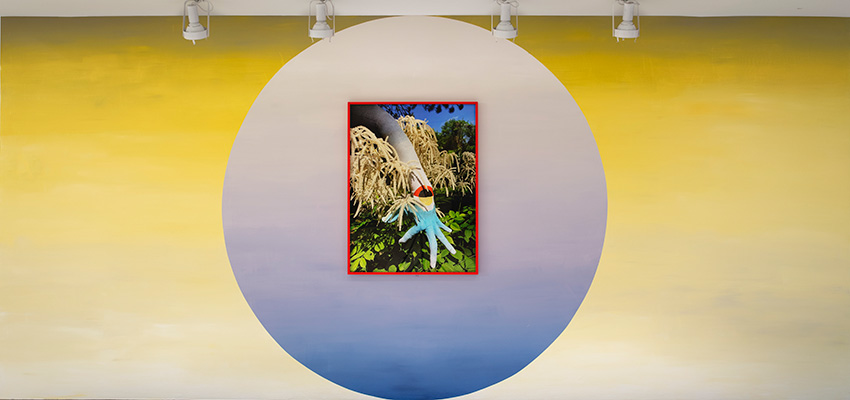
Benny Merris: Know Love Protect
October 25, 2022–February 9, 2023
How might abstraction help us understand ourselves in relation to the natural world? How does our ability to represent the world around us determine what we value enough to protect? These are some of the questions posed by Benny Merris’s ongoing series An Other Another, which brings the artist’s abstract paintings into dialogue with the environment.
To create the An Other Another works, Merris paints and then photographs his forearm in varied, often remote, landscapes. Each painting is unique and exists only for the duration of a roving photo session before it is washed away. During these sessions, Merris climbs, crawls, swims, and stretches his body to find points of connection between the painting on his arm and the environment. The resulting photographs, always taken at arm’s length, frame fleeting moments of interaction, juxtaposition, and camouflage. While Merris’s work is grounded in painting-as-process and in histories of abstraction, An Other Another is also a powerful meditation on the scale of our human impact on the landscape.
For this exhibition, which coincides with ten years of An Other Another in action, Merris animates the gallery space with site-specific wall paintings in his characteristically exuberant color palette, created in relation to the selection of recent photographs on view. Through a constellation of archival materials drawn from local archives as well as the artist’s personal collection, Merris connects An Other Another to the explorer, conservationist, and filmmaker Jacques-Yves Cousteau and Cousteau’s little-known efforts to conserve a Vermont waterway. The guiding ethos of the Cousteau Society’s conservation work—"Know Love Protect”—lends the exhibition its title and offers a model for the transformative potential of image-making.
Biography
Benny Merris is a New York-based artist from Boise, Idaho. Merris has had solo exhibitions at Cleopatra’s, Brooklyn; Jeff Bailey Gallery, Hudson; Nina Johnson, Miami; Battat Contemporary, Montreal; Cokkie Snoei, Rotterdam; Glasgow Project Room, Glasgow; and Kunsthal Rotterdam. He was a member of the inaugural Paint School cohort run by Shandaken Projects in New York City. He received a BA from the University of Massachusetts Boston and an MFA from the Glasgow School of Art. He has been artist-in-residence at Casa de los Artistas, Costa Rica; Banff Centre for Arts and Creativity; Denniston Hill; and the Offshore Artist Residency.
Exhibition Credits
Curated by Kristin Poor
Texts by Kristin Poor & Alhena Katsof
Graphic Design by LJ McNerney
Special thanks to Bob Linck, Gary Moore, and the Connecticut River Conservancy
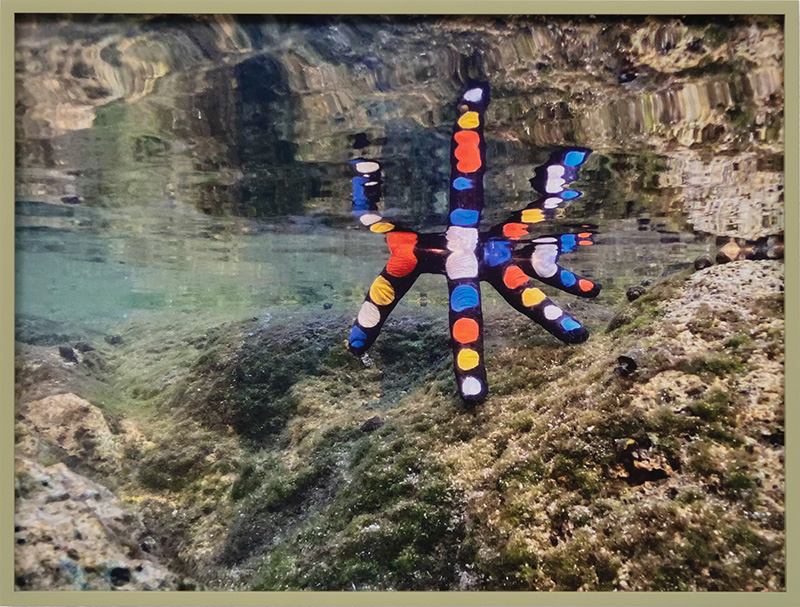
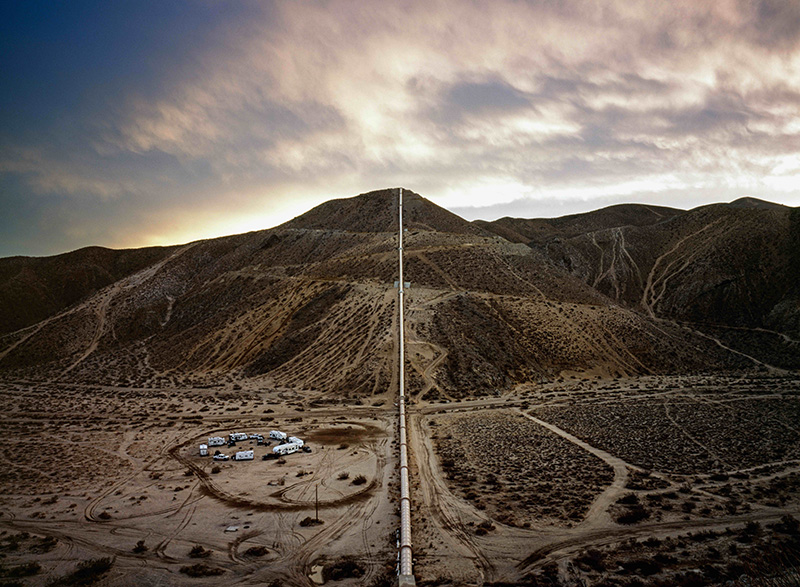
Barron Bixler: Watershed
September 12–October 18, 2022
How can we wrap our imaginations around the ecological—and increasingly existential—problem of water in California? This question drives Barron Bixler’s long-range photographic project Watershed: A Speculative Atlas of California, which draws on seven years of research and field work, and is presented here in excerpted form. Set against a backdrop of ongoing drought in the American West and the spiraling social-environmental impacts of climate change, Watershed surveys the California water system in its multiple natural and engineered forms.
The physical and political landscapes of California have been shaped by a fundamental problem of hydrology: most of the state’s water falls in the far north where most of its people and economic centers are not. Overriding the natural order—through systems that control and redirect the flow of water across watersheds—has allowed cities to bloom where they outstrip local resources, and agricultural empires to be built on shifting desert sands.
Places like Los Angeles, San Francisco, and the San Joaquin Valley—where a quarter of the nation’s and much of the world’s produce is grown—would not exist as they do today without the 13 trillion gallons of water that is shunted around California every year. This is a quantity of water so vast it could drown most of the landmass of Florida, or transform Oklahoma into an inland sea.
Most of the system that makes all of this possible is, by design, anonymous, efficient, and tucked out of sight, passing through remote landscapes or hidden underground. Bixler’s stunning photographs not only make this vast system visible, but also offer an invitation to look at what’s been built, to consider what’s been lost along the way, and to speculate on the uncertain future of water in California.
Biography
Barron Bixler is a social-environmental documentary photographer, writer, and designer. Set out in stark, unflinching images, Bixler’s photographic work explores marginal landscapes and marginalized communities, vernacular architecture, and built environments. He is a founding member of the Los Angeles-based arts collective Project 51, which was awarded a major grant by ArtPlace America for its project Play the LA River. His photographs have been exhibited at the Fresno Art Museum, Fresno; the University of California, Santa Barbara; 18 Reasons Gallery, San Francisco; and the University of Oregon, Eugene. Bixler lives in Princeton, NJ, and holds an appointment as Art and Media Specialist at Princeton University’s High Meadows Environmental Institute. A self-taught photographer, he holds a Master of Arts in English from the University of Victoria.
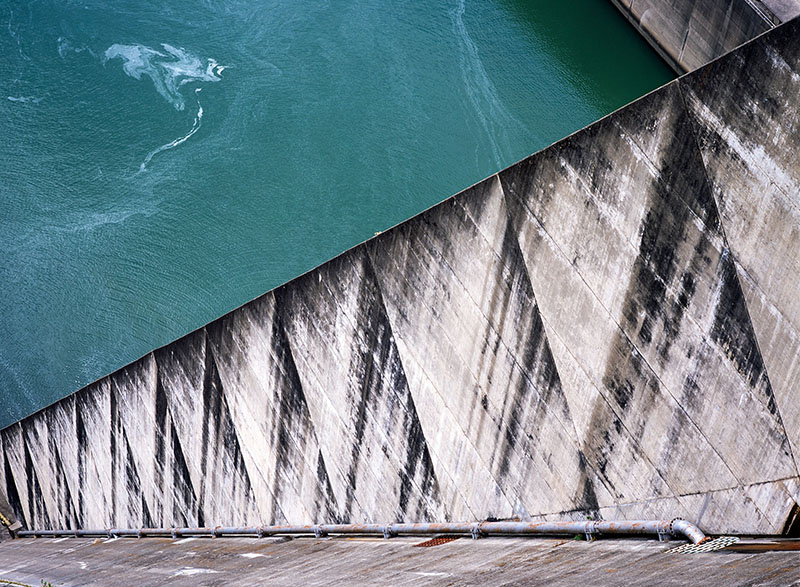

Wesaam Al-Badry: Essential Work
March 14–May 25, 2022
Since April 2020, Wesaam Al-Badry has documented the lives of essential agricultural workers and their families in California’s Central Valley and Salinas Valley. These areas represent the fertile heart of California agriculture, where farmworkers harvest over a third of the vegetables and 40% of the fruit and nuts grown in the United States.
The COVID-19 pandemic has exacerbated the vulnerabilities of these farming communities already hard-hit by housing shortages, food insecurity, unsafe working conditions, and the threat of deportation. Critical to feeding the country, California farmworkers were designated essential workers by Governor Newsom in March 2020. At least half—some advocates estimate up to 75%—of the state’s more than 400,000 farmworkers are undocumented. Despite facing high risks of contracting the virus while working, farmworkers without legal immigration status are excluded from federal pandemic relief, paid sick leave, and unemployment programs.
Al-Badry’s photographs reveal the “real people with hopes and fears” behind the fresh fruits and vegetables on our tables. During some forty visits over the past two years and in hours of recorded interviews, Al-Badry developed ongoing relationships with the people he met, visiting them at home, in their communities, and at work in California’s fields, orchards, and nut processing plants. This exhibition includes excerpts of audio interviews as well as ambient soundscapes from the fields. Together, the photographs and recordings convey resilience, empathy, and human dignity, three qualities the artist aims to foreground in all of his work.
Biography
Wesaam Al-Badry (b. 1984, Nasiriyah, Iraq) is an investigative, multimedia journalist and interdisciplinary artist working with themes related to refugees, labor, migration, war, and technology. His approach to photography is informed by his own childhood experience as a refugee. Al-Badry and his family fled the war in Iraq in 1991 and, after four and a half years in a refugee camp in Saudi Arabia, were eventually relocated to Lincoln, Nebraska. He has worked for global media outlets, including CNN and Al-Jazeera America. Photographs from this ongoing project have appeared in the New York Times, the Washington Post, Rolling Stone, Mother Jones, and The Nation. Al-Badry received a Bachelor of Fine Arts in Photography from the San Francisco Art Institute, and a Master of Journalism from the Graduate School of Journalism, University of California, Berkeley.
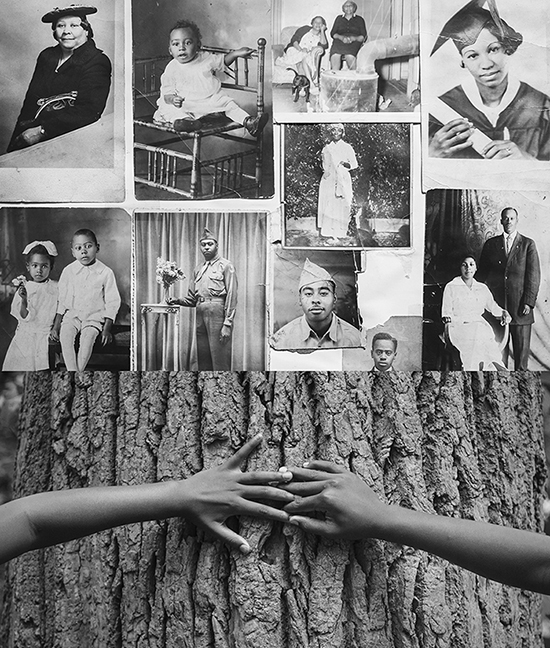
Photo Requests from Solitary: What Would Someone in Solitary Confinement Want to See?
January 10–March 9, 2022
Photo Requests from Solitary invites people in solitary confinement to request a photograph of anything at all, real or imagined, and then finds volunteers to make the images. The resulting photos are an archive of the interests, memories, and daily thoughts of people who live in extreme isolation.
The project has worked with incarcerated people and volunteer artists in California, Illinois, New Jersey, New York, and Pennsylvania. More than 200 requests and sample photos can be found on the project’s website, and anyone can fulfill a request at photorequestsfromsolitary.org.
Solitary confinement is the practice of isolating people in prison from human contact. Individuals in solitary rarely leave their cells, except to shower or exercise alone, usually in a concrete pen or a cage. Food is pushed through a slot in the cell door. There are no communal activities. Phone calls and visits are prohibited or severely restricted. This isolation and sensory deprivation can cause severe psychological and neurological damage, and solitary confinement is widely considered to be a form of torture.
The United States currently holds at least 80,000 people in solitary confinement, although there is no evidence that it makes prisons safer. People of color, young people, and people with mental illness are especially likely to be held in solitary. They are placed there solely on the authority of prison officials. More information on solitary confinement can be found at solitarywatch.org.
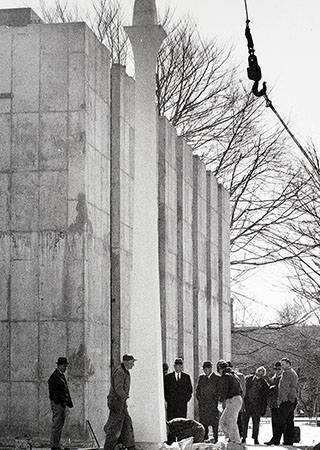
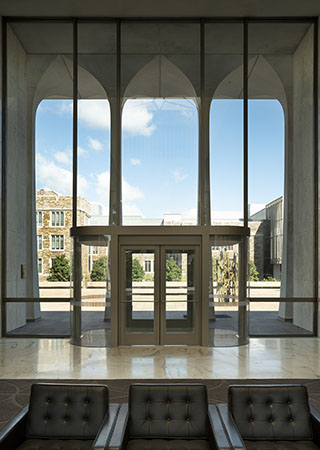
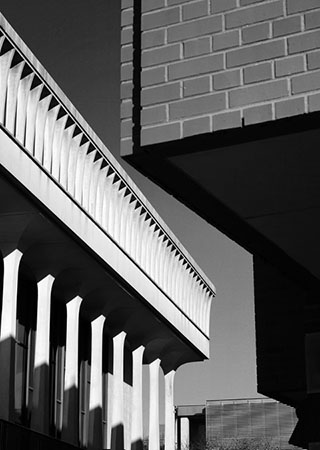
Image credits: (left) Robertson Hall; Historical Photograph Collection, Grounds and Buildings Series, AC111, Princeton University Archives, Department of Special Collections, Princeton University Library; (center) © Nic Lehoux; (right) Alan Chimacoff, Robertson, Fisher-Bendheim, Stimson Halls, 2020. www.chimacoff.com
“Speak to all people in dignity and beauty”: A History of Robertson Hall, 1961–2021
September 20–January 7, 2022
This exhibition surveys the history of Robertson Hall, home of the Princeton School of Public and International Affairs, from the building’s commission in 1961 to its reopening in fall 2021 following an extensive renovation.
Robertson Hall was conceived as the centerpiece of an ambitious expansion of the School’s curriculum and mission, made possible by a generous $35 million gift in 1961 from Charles S. Robertson (’26) and Marie H. Robertson. Completed in 1965, the building was designed by Japanese-American architect Minoru Yamasaki (1912–1986), who is best known as the architect of the former World Trade Center. The recent renovation by KPMB Architects, Toronto, respects the original character of this architectural icon while keeping an eye on the future, prioritizing environmental sustainability and expanding the flexibility of its redesigned spaces.
The exhibition includes materials drawn from the Princeton University Archives, as well as photographs by architectural photographers Balthazar Korab, Nic Lehoux, and Alan Chimacoff.
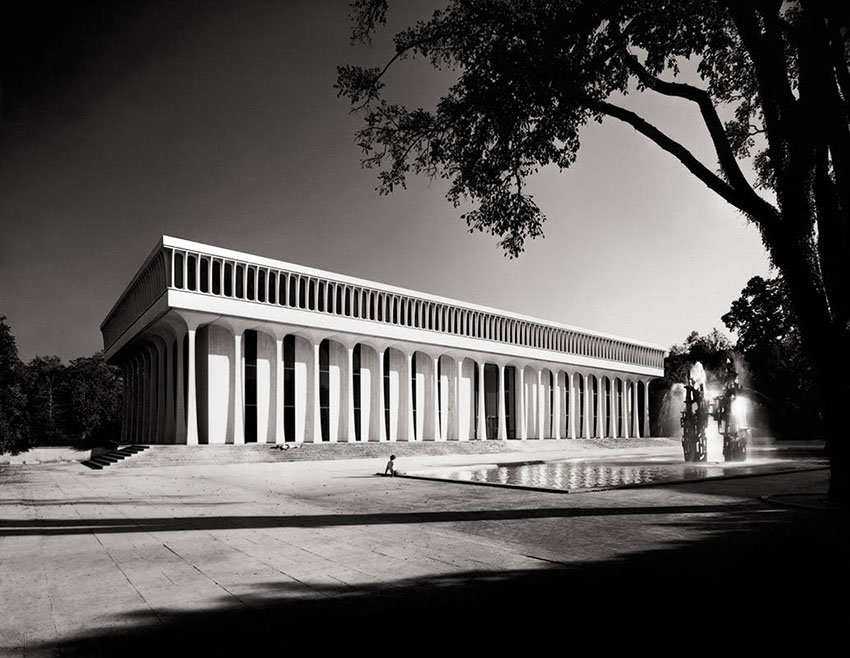
Image credit: Minoru Yamasaki & Associates, Robertson Hall, School of Public and International Affairs, Princeton University, c. 1975. Photograph by Balthazar Korab © Estate of Balthazar Korab.
Bernstein Gallery Retrospective
Flip through 15 years of political art that's been on display at the gallery. This retrospective collection was published in February 2017.
Past Events
Header image credit: © Nic Lehoux


